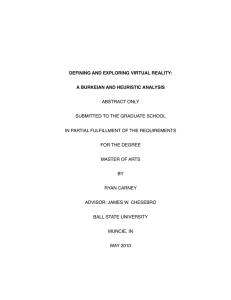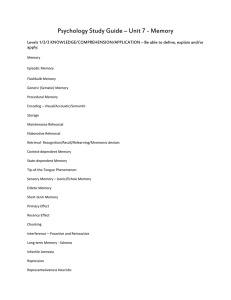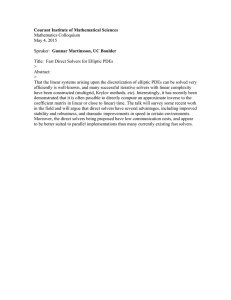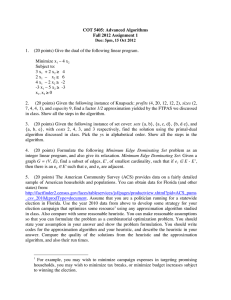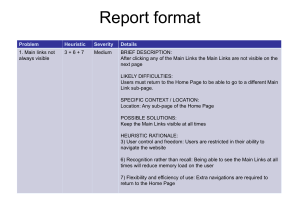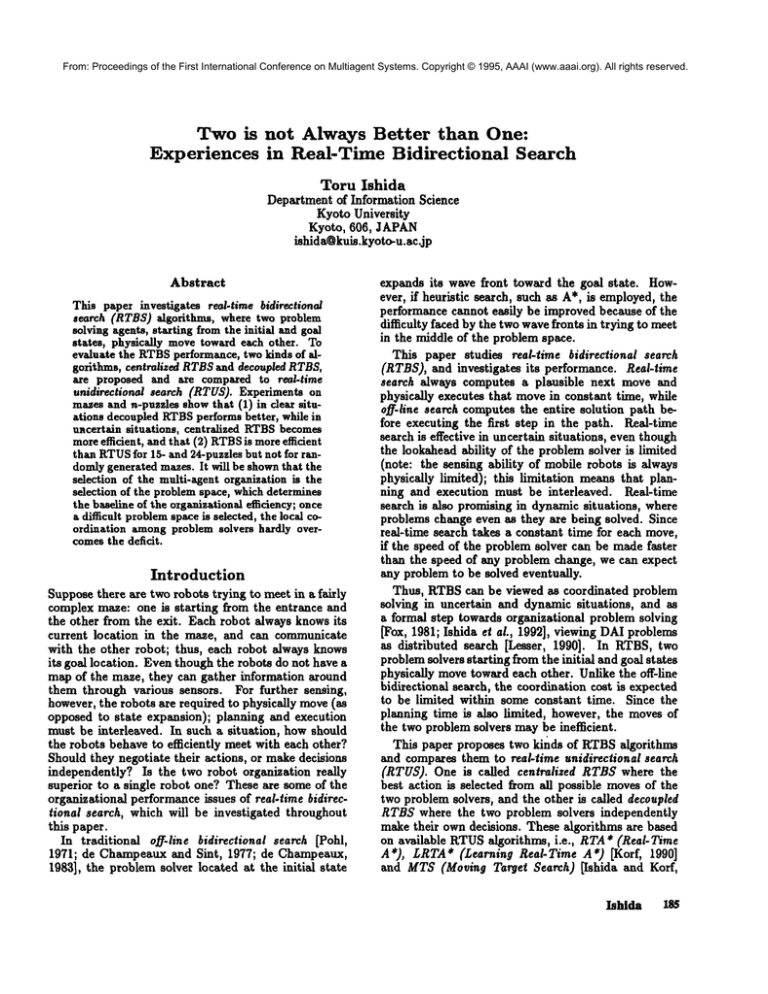
From: Proceedings of the First International Conference on Multiagent Systems. Copyright © 1995, AAAI (www.aaai.org). All rights reserved.
Two is not Always Better than One:
Experiences in Real-Time Bidirectional
Search
Toru Ishida
Department of Information Science
Kyoto University
Kyoto, 606, JAPAN
ishida@kuis.kyoto-u.ac.jp
Abstract
This paper investigates real.time bidirectional
search (RTBS) algorithms, where two problem
solving agents, starting from the initial and goal
states, physically movetoward each other. To
evaluate the RTBSperformance, two kinds of algozlthms, centralized RTBSand decoupled RTBS,
are proposed and axe compared to real.time
unidirectional search (RTUS). Experiments on
mazesand n-puzales showthat (1) in clear situations decoupled RTBSperforms better, while in
uncertain situations, centralized RTBSbecomes
moreefficient, and that (2) RTBS
is moreefficient
than RTUS
for 15- and 24-puzzles but not for randomlygenerated mazes. It will be shownthat the
selection of the multi-agent organization is the
selection of the problemspace, which determines
the baseline of the ozgamizationalefficiency; once
a difficult problemspaceis selected, the local coordination &mongproblem solvers hardly overcomesthe deficit.
Introduction
Suppose there axe two robots trying to meet in a felly
complex maze: one is starting from the entrance and
the other from the exit. Each robot always knows its
current location in the maze, and can communicate
with the other robot; thus, each robot always knows
its goal location. Even though the robots do not have a
map of the maze, they can gather information around
them through various sensors. For further sensing,
however, the robots are required to physically move(as
opposed to state expansion); planning and execution
must be interleaved. In such a situation, how should
the robots behave to efficiently meet with each other?
Should they negotiate their actions, or make decisions
independently? Is the two robot organization really
superior to a single robot one? These are some of the
organizational performance issues of real.time bidirectional search, which will be investigated throughout
this paper.
In traditional off-line bidirectional search [Pohl,
1971; de Champeaux and Sint, 1977; de Champeanx,
1983], the problem solver located at the initial state
expands its wave front toward the goal state. However, if heuristic search, such as A*, is employed,the
performance cannot easily be improved because of the
difficulty faced by the two wavefronts in trying to meet
in the middle of the problem space.
This paper studies real-time bidirectional search
(RTBS), and investigates its performance. Real-time
search always computes a plausible next move and
physically executes that movein constant time, while
off-line search computes the entire solution path before executing the first step in the path. Real-time
search is effective in uncertain situations, even though
the lookahead ability of the problem solver is limited
(note: the sensing ability of mobile robots is always
physically limited); this limitation means that planning and execution must be interleaved.
Real-time
search is also promising in dynaxnic situations, where
problems change even aa they are being solved. Since
real-time search takes a constant time for each move,
if the speed of the problem solver can be made faster
than the speed of any problem change, we can expect
any problem to be solved eventually.
Thus, RTBScan be viewed as coordinated problem
solving in uncertain and dynamic situations,
and as
a formal step towards organizational problem solving
[Fox, 1981; Ishida et aL, 1992], viewing DAIproblems
as distributed search [Lesser, 1990]. In RTBS, two
problemsolvers starting from the initial and goal states
physically movetoward each other. Unlike the off-line
bidirectional search, the coordination cost is expected
to be limited within some constant time. Since the
planning time is also limited, however, the moves of
the two problem solvers may be inefficient.
This paper proposes two kinds of RTBSalgorithms
and compares them to real-time unidirectional search
(RTUS). One is called centralized RTBS where the
best action is selected from all possible moves of the
two problem solvers, and the other is called dccoupled
RTBS where the two problem solvers independently
make their own decisions. These algorithms are based
on available RTUSalgorithms, i.e., RTA*(Real-Time
A*), LRTA* (Learning Real-Time A*) [Korf, 1990]
and MTS (Mo~ing Target Search) [Ishida and Koff,
Lshlda
From: Proceedings of the First International Conference on Multiagent Systems. Copyright © 1995, AAAI (www.aaai.org). All rights reserved.
1991; 1995; Ishida, 1992a]. An experimental evaluation has been made using mazes and n-puzzles, the
most commonexamples in the area of search.
RTBS Algorithms
Pohi proposed the framework of off-line bidirectional
search: the control strategy first selects forward or
backwardsearch, and then performs the actual state expansion [Pohl, 1971]. Wehere propose the framework
of RTBSalgorithms, which inherits the framework of
off-line bidirectional search. The difference from Pohl’s
framework is that, in RTBS,the forward and backward
operations are not state expansions but physical moves
of the problem solvers.
In RTBS,the following steps are repeatedly executed
until the two problem solvers meet in the problem
space.
1. Control strategy:
Select a forward (Step~) or backward move(Step3).
2. Forwardmove:
The problem solver starting from the initial state
(i.e., the forward problem solver) moves toward the
problem solver starting from the goal state.
3. Backward move:
The problemsolver starting from the goal state (i.e.,
the backward problem soh, er) moves toward the problem solver starting from the initial state.
In RTBS,control strategies are crucial for characterizing the autonomy of the problem solvers: RTBS
algorithms can be classified into the following two categories depending on the autonomy of the problem
solvers. In centralized control, control strategy evaluates all possible forward and backward moves, and
selects the best one. As a result, the movesof the two
problem solvers are completely controlled by the centralized decisions. Whenadopting centralized control,
forward and backward moves are not always performed
alternately. In decoupled control, on the other hand,
control strategy employs the minimal control necessary to guarantee the termination of the algorithm. As
a result, the two problem solvers maketheir decisions
independently. In the algorithms described in this section, the control strategy simply selects forward and
backward moves alternately.
In addition to the type of control, the RTBSalgorithms can be further classified from the information
sharing point of view, i.e., how two problem solvers
share heuristic distances. In shared learning, the forward and backwardproblem solvers share heuristic values, h(z, y), and maintain the values together. In distr~buted learning, each of the forward and backward
problem solvers maintains its ownheuristic values, say
hl(z,y ) and hb(z,y). The initial values of hy(z,y)
and hb(z, y) might be different, because each problem
solver can employ its own heuristic function.
186
ICMAS-9$
In the following two subsections, only the two extremes of the four possible combinations (centralized
control with shared learning and deconpled control with
distributed learning) will be investigated. Wesimply
call the two extremes centralized RTBS. and deeoupled
RTBS. The two combinations that remain will not
be discussed, because they can be generated rather
straightforwardly,
and their individual performance
lies somewhere between the two extremes.
Let us take an n-puzzle example. The KTBSalgorithm utilizes two game boards. At the beginning, one
plate indicates the initial state and the other indicates
the goal state. The aim in this case is to achieve identical puzzle states. Centralized RTBSbehaves aa if
one person operates both game boards, while deeoupied RTBSbehaves as if each of two people operates
his/her own game plate independently.
Centralized
RTBS
Below, we describe a centralized
RTBSalgorithm
called LKTA*/B,which is a bidirectional version of
LRTA*.The positions of two problem solvers are represented by z (forward) and y (backward), while
estimated distance between two problem solvers is represented by h(z, y).
[LRTA*/B]
I. Control strategy:
(a) Calculate h(z’, y) for each neighbor z’ of
Calculate h(z, y’) for each neighbor y, of
(b) Updatethe value of h(z, y) as follows:
h(x, y) ,-- min=,,~,{ h(z,
y’)
h(z’,y)+l
(c) If min=,h(z’,y) < miny,h(z,y’) select a forward
move.
If rain=:, h(z’, y) > rainy, h(z, y’) select a backward
move.
Otherwise, select a forward or backwardmoverandomly.
2. Forward move:
Movethe forward problem solver to the neighbor z’
with the minimumh(z’,y), i.e., assign the value
z t to z. (Ties are broken randomly.)
3. Backward move:
Movethe backward problem solver to the neighbor
y’ with the minimumh(z, y’), i.e., assign the value
of y~ to y. (Ties are broken randomly.)
RTA*/B is similar to LRTA*/B, but it utilizes
the second minimumvalue for updating heuristic distances. Both LRTA*/Band RTA*/B are complete as
follows.
Theorem 1:
In a finite problem space with positive edge costs,
in which there exists a path from every node to the
From: Proceedings of the First International Conference on Multiagent Systems. Copyright © 1995, AAAI (www.aaai.org). All rights reserved.
goal, and starting with non-negative admissible initial heuristic values, both ItTA*/B and LItTA*/B
are complete in the sense that the forward and backward problem solvers will eventually share the same
state.
The proof is obtained by showing that the centralized RTBSalgorithms is equivalent to applying the
corresponding KTUSalgorithms to the RTBS problem
space.
Decoupled
RTBS
At this time, MTSis the only algorithm that can handle situations in which both the problem solver and the
goal move. Therefore, decoupled KTBSshould employ
MTS for both forward and backward moves. In the
following description, z and y indicate the positions
of the forward and backward problem solvers, while
h! (z, y) and hb(z, y) indicate the heuristic distances estirnated by the forward and backward problem solvers,
respectively. Note that the initial values of hi(z,!)
and hb(z, y) may be different, because the two problem solvers can utilize different heuristic functions.
[MTS/B]
1. Control strategy:
Select a forward or backward move alternately.
2. Forward move:
For the forward problem solver:
(a) Calculate hy(x ~, y) for each neighbor x~ of x.
(b) Update the value of hy(z,y) as follows:
hl(z,
y) *- maz{rnin=,{hy(x,
hs(z,y)
y) 1}
}
(c) Move to the neighbor z ~ with the minimum
h/(z~,y), i.e., assign the value of z ~ to z. (Ties
are broken randomly.)
For the backward problem solver:
(a) Calculate hb(xZ, y) for the forward problem
solver’s new position zg
(b) Update the value of hb(x, y) as follows:
h~(x,y) .- maz
/,b(z’,
{h,(x,y)y)
}
(c) Reflect the forward problem solver’s move to the
backward problem solver’s goal, i.e., assign the
value of z’ to z.
Backtvard
mo~e: Analogous to the forward move,
3.
described above.
The original MTSalgorithm assumes that the problem solver moves faster than the target. This assumption was introduced to prevent the target from escaping the problem solver forever. The same assumption
is even required in MTS/B, however, where the two
problem solvers try to meet each other.
Theorem 2:
In a finite problem space, in which a path exists between every pair of nodes, starting with non-negative
admissible initial heuristic values, the forward and
backward problem solvers executing MTS/Bwill
eventually share the same state, if the two problem
solvers movealternately, and the forward (or backward) problem solver periodically skips some of its
moves.
Theorem 2 demonstrates
the completeness
of
MTS/B. The proof can be derived like that for MTS
[Ishida and Korf, 1991].
Performance Analysis
This section examines the performance of the RTBS
algorithms. The computational complexity will be investigated first, and then the actual performance will
be measured on typical example problems.
Computational
Complexity
Figure l(a) illustrates the search tree for ILTUS.Each
node represents a position of the problem solver. An
examplepath from the initial state to the goal state is
represented by the thicker line. Let By be the number
of operators (branching factor) for the forward move,
B6 be the number of operators for the backward move,
and D be the number of moves before reaching the
goal state. Then, the number of generated states can
be represented by By × D.
The key to understanding the RTBSperformance
is to assume that KTBSalgorithms solve a totally different problem from RTUS;i.e., the difference between
P~TUSand ItTBS is not the number of problem solvers,.
but their problem spaces.
Let an KTBSstate be a pair of ItTUS states of two
problem solvers: where z and y are RTUSstates. Then
the pair of ItTUS states (z, #) becomesan ttTBS state.
Thus, when the number of RTUSstates is n, the number of RTBSstates becomesn2. Let i be the RTUSinitial state, and g be the ItTUSgoal state; then, the pair
of RTUSstates (i, g) becomesthe RTBSinitial state.
The goal state of RTBSrequires both problem solvers
to share the same l~US state, i.e., consequently, all
(z,y), where z -- y, are RTBSgoal states. Thus, the
RTBSgoal state is not unique, i.e., whenthere is one
ttTUS goal state and n RTUSstates, there are n RTBS
goal states. Each state transition in the RTBSproblem space corresponds to a move by one of the problem
solvers. Thus, the branching factor in RTBSis the sum
of the branching factors of the two problem solvers.
Figure l(b) represents the search tree for centralized
RTBS.At each move, the best action is selected from
all possible By -I- B~movesof the two problemsolvers.
Let D be the sum of the moves of the two problem
solvers before meeting each other. Then, the number
of generated states can be represented by (Bj-FBb)×D.
Ishida
187
From: Proceedings of the First International Conference on Multiagent Systems. Copyright © 1995, AAAI (www.aaai.org). All rights reserved.
,4i-~
’.
’
I
" Jk"
/fl
/~
~
, .///
i
.
(a) RTUS
Co) Centralized RTBS
Bb
,4qi;~,,.~
/Ar I k ".2."......
(c) DecouplcdRTBS
Figure 1: Comparison of Computational Complexities
In decoupled RTBS, two problem solvers independently make their own decisions and alternately move
toward the other problem solver. Let us assume, however, that even in decoupled RTBS, the two problem
solvers move in art RTBSproblem space. Figure 1(c)
represents the search tree for decoupled RTBS. Each
problem solver selects the best action from possible B/
or Bb moves(represented by solid edges), but does not
examine the moves of the other problem solver (represented by dashed edges). Therefore the selected action
may not be the best among all the possible B/+ Bb
moves of the two problem solvers. Let D be the sum
of the moves of the two problem solvers. Since decoupled RTBSuses partial information, D increases
in contrast to centralized RTBS. On the other hand,
the number of generated states can be represented by
{(By+ Bb)/2}× D, whichcandecrease
in contrast
centralized
RTBS.
Measurement
on Typical
The RTUSand RTBS algorithms
typical path finding problems.
Problems
are applied
to two
(1) Randomly Generated Mazes
Mazes have been used for testing search algorithms,
in particular bidirectional search [Kwa, 1989]. In
this measurement, we represent a maze as a grid
space, replacing an arbitrary number of junctions
by obstacles. With a high obstacle ratio (more than
20%), the obstacles combine and form walls of various shapes. The complexity of the maze rapidly
increases as the ratio increases from 25% to 35%.
At the start, two problem solvers are placed so that
the Manhattandistance between them is 50 (i.e., the
direct path between the initial and goal states consists of 50 edges). Both problem solvers can move
up, down, right or left in the grid space. The Manhattan distance is used as the heuristic function.
(2) n-Puzzles
188
ICMAS-95
n-puzzle problems, especially 15-puzzles, have been
appearing repeatedly in bidirectional search literature [Pohl, 1971; de Charnpeanx et al. 1977; Politowski and Pohl, 1985]. In this evaluation, with
15-puzzles, the first ten problems of the 100 problems presented in [Korf, 1985] are used. A further
evaluation is based on ten randomly generated 24puzzles. The distance between two n-puzzle states
is estimated by summing the Manhattan distances
betweenthe locations of all the tiles.
Figures 2 to 4 display the experimental results. The
z-axis represents the obstacle ratio in mazes and the
problem ID in n-puzzles. The y-axis represents the total number of moves, generated states, and the CPU
time taken by the two problem solvers. Note that
the number of generated states determines the planning time, and the number of moves determines the
execution time. Programs are written in Allegro CommonLisp running on a SparcStation2. The results in
Figures 2 and 3 are obtained by averaging 100 trials,
while Figure 4 uses only 30 trials due to the limitations
of computing resource.
The superiority or inferiority of centralized and decoupled RTBSdepends on whether the situation is
clear or uncertain, i.e., whether the heuristic function
returns accurate values or not.
¯ In clear situations (i.e., heuristic functions return
accurate values), decoupled RTBSperforms better.
From the maze experiences in Figure 2, when the
obstacle ratio is low, there is not muchdifference in
the number of moves between centralized and decoupied RTBS.This means that, in clear situations, two
problem solvers can independently make decisions
without losing efficiency. However,since centralized
RTBSexpands twice as many states as decoupled
RTBS, the planning time for decoupled RTBSis almost 1/2 that of centralized RTBS.
¯ In uncertain situations (i.e., heuristic functions return inaccurate values), centralized RTBSperforms
From: Proceedings of the First International Conference on Multiagent Systems. Copyright © 1995, AAAI (www.aaai.org). All rights reserved.
S000
/
/
®2500
/
S:
Z 1000
soo
Io
9000]
8000:,
7000,
!
6000
!
7O(o
B0(o
/
/
/
&4o(o
O
4ooo,!
aooo,!
//.
o
O20(o
§
10
15
20
2S
30
35
ObstacleFtmlo(%)
0
s 10 is 2o 25 3o 35
O~htde
Ratio(%)
(b)
(a)
~ RTA"
~ LRTA"
(RTUS)
AV
10( o
looo
I I
o
0
/
//
o
ol
0
S 10 lS 20 2S 30 35
Obstacle
Ratk)(%)
(el
-,4- RTA*/B-,m-.. LRTA’#B
(Centmli~sd
RTBS)
-6- MT~B
I
(De0ouplKI
RTBS)
I
Figure 2: Performance for RandomlyGenerated Mazes
better. It is clearly observedfromthe mazeexperiences that, as the situation becomesuncertain (the
obstacle ratio exceeds 20%), centralized RTBSbecomes muchmore efficient than decoupled RTBS.
The n-puzzle experiences in Figures 3 and 4,1 also
showthat the numberof movesfor centralized RTBS
is about 1/2 that of decoupled RTBS.
By comparing RTUSand RTBSperformances, interesting observations can be made.
¯ In clear situations, both RTUSand RTBShave a
similar performance. Our mazeexperiences in Figure 2 showthat, in clear situations, wherethe obstacle ratio is less than 10%,the numberof moves
in RTUSand RTBSare not muchdifferent. This is
because, in clear situations, near optimal solutions
can be easily obtained by applying various search
techniques.
¯ In uncertain situations, the superiority or inferiority of RTUSand RTBSrelies hea~ily on the problem
type. RTBS
can solve 15- and 24-puzzles with fewer
movesthan RTUSas in Figures 3 and 4; the number of movesfor centralized RTBSis approximately
halved for 15-puzzles and reduced by a factor of 6
for 24-puzzles comparedto RTUS.In randomlygenerated mazes, however, whenthe obstacle ratio becomes more than 10%, Figure 2 shows that RTBS
ZIn mazes, when the obstacle ratio becomes 35%, while
the optima] path length is 60 to 80, the number of moves
becomes400 to 4000, i.e., T to 50 times longer than the optimal path length. Similarly, in 15-puzzles, while the optimal
path length is 40 to 60, 2000 to 5000 moves are required,
i.e., 50 to 80 times longer than the optimal path length.
These numbers show that the situation in 15-puzzles is as
uncertain as that in fairly complex mazes.
cannot perform better than RTUS.As the obstacle ratio increases, this tendencybecomeseven more
clear; the numberof movesfor RTBS
is roughly doubled compared to RTUS.
Heuristic Topographies
The performanceof real-time search depends greatly
on the topography of the estimated problem space.
This is because, in real-time search, the problemsolver
alwayscommitsto its decision, and thus will seriously
affect the consequentproblemsolving process. To explain the problemsolver’s behavior, wedefine a heuristic depression,with respect to a single goal state, as a
set of connectedstates whoseheuristic values are less
than or equal to those of the set of immediateand completely surroundingstates. Note that no depressionexists in the actual distance. However,as the situation
becomesuncertain, heuristic values differ significantly
fromthe actual distances, and so heuristic depressions
tend to appear morefrequently in the problemspace.
The real-time problemsolver repeatedly movesalong
the slope of heuristic values. If an erroneousdecision
is madeat the boundaryof a heuristic depression, the
problem solver cannot stop moving toward the bottom of the depression. Whenplaced in a heuristic
depression, the problem solver often finds no wayof
decreasingthe heuristic difference, and recognizesthat
its heuristic values are inaccurate. In such cases, the
problemsolver cannot reach the target without "filling" the depression by repeatedly updating the heuristic values. To summarize,the performancebottleneck
of real-time searchresu/ts fromits inej~iciencpin filling heuristic depressions. This fact will be the key to
understanding the RTBSperformance.
Webelieve the RTBSperformance, measuredin the
previous section, results from the difference between
Ishida
189
From: Proceedings of the First International Conference on Multiagent Systems. Copyright © 1995, AAAI (www.aaai.org). All rights reserved.
16000,,
=!
14000]
12000.:
1000O
.:
w
o,
8000.: Ip ~, ,#
w
6000.:
4000.:
2000O
2000]
0.:
1 2 3 4 5 8 7 8 910
ProblemID
123
{c)
(b)
I
~ RTA"
o LRTA*
(RTUS)
-4--
RTA’/B -a- LRTA*/B
(Centndlzed
RTBS)
45678910
ProblemID
(OecouplKI
R’I’B8)
Figure 3: Performancefor 15-Puzzles
20000O
180000
16000O
140000
120000
100000
r3 80000
15
50000
6O0OO
,A
V
,0000
\
500OO
I
w
15 3OO00
]bd~ A
.b
1000O A..A,. &,
A m- IlL ,eb, ’ll~*,n--
I l~,~r,
~
~
V
,m
II
~
I~I
I~I ~ ’~
~ 4~
II
z
-- m. m...m
o
0
1 2 3 4 5 6 7 8 91o
ProblemID
1 2 3 4 5 8 7 8 910
ProblemID
(a)
(b)
RTA*
~ LRTA*
-.4-
(RTUS)
RTA*/B -!- LRTA*/8
(CenVallzed
RTBS)
1 2 3 4 5 6 7 8 9 10
ProblemID
(c)
.-4,- MTS,’B
(Deooupled
RTBS)
Figure 4: Performancefor 24-Puzzles
the RTUSand RTBSproblem spaces. Our expectation
is that the effectiveness of RTBScan be determined by
comparing the two problem spaces. Unfortunately, the
problem spaces (especially the RTBSproblem spaces)
of the example problems are too large to examine with
existing computer systems. This section therfore provides a complete example of topographical changes between the RTUSand RTBSproblem spaces to provide
better understanding of the R,TBSperformance.
Figure 5 displays two RTUSproblem spaces of 15 x
15 mazes. Figure 5(a) represents the mazewith a single
wall (we call this mazeBar), while Figure 5(b) includes
three walls (we call this maze Hole). In both mazes,
the initial state is representedby I, and the goal state
byG.
The heuristic depressions in the lgTUS problem
spaces are represented by dark areas. In both mazes,
190
ICMAS-9$
heuristic depressions are spread between the initial
state and walls. Table 1 summarizesthe width, depth,
capacity, circumference, ezit and n~mberof heuristic
depressions. The width represents the numberof states
in a heuristic depression. Wecall a state an ezit of a
depression, if the state is a part of the circumference,
and if its heuristic value is equal to that of the adjacent outside state. The depth indicates the maximum
difference betweenthe heuristic value of any state in
the depression andthat of the czit. Since the heuristic
depression is defined as a set of states whoseheuristic
distances are less than or equal to those of surrounding states, the depth can be 0. The capacity is defined
as ~’~(depth(i) 1)where i r epresents a s tate in the
depression. This is to reflect the width of the depression to the capacity. The circumference represents the
numberof states, each of which belongs to the depres-
From: Proceedings of the First International Conference on Multiagent Systems. Copyright © 1995, AAAI (www.aaai.org). All rights reserved.
[ ....
(a) Bar
Co) Hole
I:
0:
Initial state
Goalstate
Ill:
Obstacles
Heuristic depsressions in the RTUSproblemspace
[]:
a,b,c,d: Pairs of problemsolvers’ states resulting
heuristic depressions in the RTBS
problemspace
$,#:
Circumference(both $ and #) and exit (#)
Figure 5: Two Mazes
sion but is adjacent to the outside of the depression.
In Figure 5(a), for example, the circumference is represented by $ and #, and the ezit by #.
Recall that the ItTBS state is composed of a combination of two RTUSstates. Thus, the heuristic depressions in the RTBSproblem space are caused by
the positions of two problem solvers. For example,
a pair of positions across the wall creates a heuristic depression. Table 1 represents all locally maximal
heuristic depressions in the RTUSand ItTBS problem spaces. To compute all depressions, an exhaustive
search was performed in both the RTUS and RTBS
problem spaces. Pairs of problem solver positions,
which cause the heuristic depressions, are indicated as
a,b, c, d both in Figure 5 and Table 1. The major observations from Table 1 are as follows.
¯ In the RTUSproblem space, each maze contains one
deep heuristic depression.
¯ In the RTBSproblem space, the heuristic topography changes significantly.
In Bar, both the depth
and capacity of the depression decrease dranmtically,
compared to the RTUSproblem space. On the other
hand, in Hole, the depth decreases, while the capacity increases by the factor of 102.
Whyis RTBSeffective for 15- and 24-puzzles, but
not for randomly generated mazes? Intuitively, as the
width and depth of heuristic depressions increase, it becomesdifficult to get out of them. In such a situation,
the capacity can indicate the cost of the search. However, wide and shallow depressions with a long circumference (especially with a wide exit) are not too hard
to get out, even if the depressions are fairly wide. In
/tTBS, since the problem space is widened, the number
of states in heuristic depressions also increases. This
leads to a problem that is difficult to solve. On the
other hand, since various paths axe created, heuristic
depressions in RTBSbecome shallow. This leads to a
problem that is easy to solve. These effects are combined and appear differently in different problems. We
measured the number of moves of the RTUSand RTBS
algorithms on the two mazes in Figure 5. In Bar, the
number of moves of LRTA*/Bis between a half and
two third compared to LRTA*,while in Hole, it is 10
times greater than that of LRTA*.
Conclusion
This paper has proposed real-time bidirectional search
(RTBS) algorithms, and has investigated their performance. Several issues still remain unresolved. In
previous research, where off-line search has primarily been studied, heuristic functions have been investigated from the probabilistic point of view [Pearl, 1984].
However, as shown in this paper, the performance of
real-time search is sensitive to heuristic depressions.
Weare now aware that heuristic topography is crucial to understanding the real-time search performance,
and that we must establish a theory behind the topographical changes between the RTUSand RTBSproblem spaces.
This work can be considered as the first step toward
organizational problem solving [Ishida, 1992b; Ishida,
1993]. Note that RTBSis not the only way to organize
two problem solvers. Another possible way is to have
Ishida
191
From: Proceedings of the First International Conference on Multiagent Systems. Copyright © 1995, AAAI (www.aaai.org). All rights reserved.
Bar
Width ] Depth Capacity I ] Circumference(Exit)
ze
ProblemSp’~
RTUS
a
n
RTBS
b
m
Hole
Number
Circun~
61
7
201
14(2)
1
79
13
641
2 (2)
1
1
63
1
2
76
I (1)
52(2)
2
2
37
1
8
i
50
26 (2)
579(4)
2
2
1
2381
23
i
¢
d
i
7379
29
2
18 (t)
I (I)
8
4
Table 1: Heuristic Depressions in the TwoMazes
both problem solvers start from the initial state and
move toward the goal state. The problem space then
becomes different
from the KTBScase. This means
that the selection of the multi-agent organization is
the selection of the problem space, which determines
the baseline of the organizational efficiency; once a diffcult problem space is selected, the local coordination
among problem solvers hardly overcomes the deficit.
The theory behind the KTBSperformance will provide
a computational basis for coordinating and organizing
multiple problem solving agents.
Let us revisit the example at the beginning of this
paper. The two robots first make decisions independently to move toward each other. However, the problem is hardly solved. To overcome this inefficiency,
the robots then introduce centralized decision making
to choose the appropriate robot to move next. They
think that two is better than one, because the two
robot organization has more freedom for selecting actions; better actions can be selected through sufficient
coordination. However, the result appears miserable.
The robots are not aware of the changes that have occurred in their problem space.
Acknowledgments
The author thanks Richard Korf, Kazuhiro Kuwabara
and MakotoYokoofor their helpful discussions.
References
[de Champeaux and Sint, 1977] D. de Champeaux
and L. Sint, "An Improved Bidirectional Heuristic
Search Algorithm, " J. ACM, Vol. 24, No. 2, pp.
177- 191, 1977.
[de Champeaux, 1983] D. de Champeaux, "Bidirectional Heuristic Search Again, " J. ACM,Vol. 30,
No. 1, pp. 22-32, 1983.
[Fox, 1981] M. S. Fox, "An Organizational View of
Distributed Systems," IEEE Transactions on Systems, Man, and Cybernetics, Vol. 11, No. 1, pp. 7080, 1981.
[Ishida and Korf, 1991] T. Ishida and R. E. Korf,
"Moving Target Search," IJCA[-gl, pp. 204-210,
192
ICMAS-95
1991.
[Ishida, 1992a] T. Ishida, "MovingTarget Search with
Intelligence," AAAI-92, pp. 525-532, 1992.
[Ishida, 1992b] T. Ishida, "The Tower of Babel:
Towards Organization-Centered Problem Solving,"
111h Distributed Artificial Intelligence Workshop,
pp. 141-153, 1992.
[Ishida et al., 1992] T. Ishida, L. Gasser and
M. Yokoo, "Organization
Self-Design
of Distributed Production Systems," IEEE Transactions
on Knowledge and Data Engineering, Vol. 4, No. 2,
pp. 123-134, 1992.
[Ishida, 1993] T. Ishida, "Towards Organizational
Problem Solving," IEEE International Conference
on Robotics and Automation, pp. 839-845, 1993.
[Ishida and Koff, 1995] T. Ishida and K. E. Korf,
"A Moving Target Search: A Real-Time Search for
Changing Goals," IEEE Transactions on Pattern
Analysis and MachineIntelligence, 1995 (to appear).
[Korf, 1985] R. E. Korf, "Depth-first IterationDeepening: An Optimal Admissible Tree Search,"
Artificial Intelligence, Vol. 27, No. 1, pp. 97-109,
1985.
[Korf, 1990] K. E. Korf, "Real-Time Heuristic
Search, ~ Artificial Intelligence, Vol. 42, No. 2-3,
pp. 189-211. 1990.
[Kwa, 1989] J. B. H. Kwa, "An Admissible Bidirectional Staged Heuristic Search Algorithm," Artificial
Intelligence, Vol. 38, pp. 95-109, 1989.
[Lesser, 1990] V. K. Lesser, "An Overview of DAh
Viewing Distributed AI as Distributed Search,"
JSAI Journal, Vol. 5, No. 4, pp392-400, 1990.
[Pearl, 1984] J. Pearl, Heuristics: Intelligent Search
Strategies for Computer Problem Solring, AddisonWesley, Reading, Mass., 1984.
[Pohl, 1971] I. Pohl, "Bi-directional Search," Machine
Intelligence, Vol. 6, pp. 127-140, 1971.
[Politowski and Pohl, 1985] G. Politowski and I.
Pohl, "D-node Retsrgetting in Bi-directional Heuristic Search," AAAI-84, pp. 274-277, 1984.

